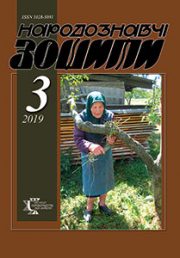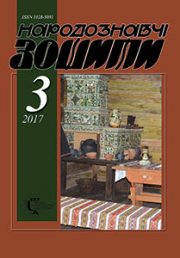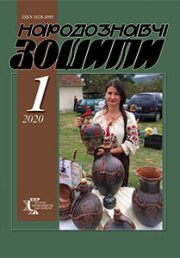The Ethnology Notebooks. 2022. № 4 (166), 897—909
UDK 27-523.47-526.62(477.86-21)”16/17″
DOI https://doi.org/10.15407/nz2022.04.879
KOSIV Roksolana
- ORCID ID: http://orcid.org/0000-0002-1202-1488
- Doctor in Art Studies, Head of Sacral Art Department,
- Lviv National Academy of Arts,
- 38, Kubiiovycha Street, 79011, Lviv, Ukraine,
- National Museum in Lviv named after Andrey Sheptytskyi,
- Senior scholar,
- 20, Svobody avenue, 79000, Lviv, Ukraine,
- Contacts: e-mail: lanakosiv@yahoo.com
Abstract. Problem statement. Studyof the activity of professional icon painters who worked in the 17th century and localized in Lviv and smaller towns near to it — Kamyanka-Buzka and Zhovkva still remains a priority of art historians. These masters, as it is known, were the leaders in establishing new «fashionable» directions in Ukrainian iconpainting, and iconpainters from other areas looked up to them. If larger ensembles of icons and iconostases, associated with the work of Lviv and Zhovka masters of the 17th century were studied and are well-known, some icons made in the same or similar manner still deserve attention. Such is the Passion of Christ icon of 1675, which comes from the church of St. Nicholas in Kamianka-Buzka, Lviv Region and it is stored at the National Museum in Lviv named after Andrey Sheptytskyi.
The purpose of the articleis to study the Passion of Christ icon of 1675 from the Church of St. Nicholas in Kamianka-Buzka and to introduce it into the context of the activities of icon painters from Lviv, Kamianka-Buzka and Zhovkva.
The methods of formal and iconographic analysis, the method of reconstruction and the method of researching the cultural context were applied.
Conclusions. The 1675 Passion of Christ icon from the church of St. Nikolas in Kamianka-Buzka, as well as the Kamianka-Buzka Passion of Christ icon of 1673 by Matei Domaradskyi, is an important source for revealing the activities of the masters of the Kamianka-Buzka and Zhovkva areas, their artistic contacts, common sources of iconography and stylistics of painting. There is a noticeable common features between the iconpainting of the author of the Passion of Christ icon of 1675 from Kamianka-Buzka and Lviv and Zhovka masters who were oriented towards the Western European patterns. On the basis of archival sources, preserved icons of Apostols from the iconostasis from St. Nikolas church in Kamianka-Buzka and in a comparison with the iconpainting manner of Ivan Rutkovych, who could be an apprentice to the author of the 1675 Passion icon, we hypothetically attribute the studied icon, and some other works, mainly Apostols from the Deesis tier of the iconostasis from the church in Yarychiv, to Kamianka-Buzka painter Roman Mohylnytskyi.
Keywords: icon, church, Passion of Christ, iconpainting center, church art, Kamianka-Buzka, painter Roman Mohylnytskyi.
Received 7.07.2022
REFERENCES
- Sydor, O. (1998). Icons from Kamianka-Buzka in the collection of the National Museum in Lviv. Galician Gate, 8 (44), 8 [in Ukrainian].
- Aleksandrovych, V. (2005). Matvii Domaratskyi, painter from Lviv and Komarno. Sights of Ukraine: history and culture, 1, 40—65 [in Ukrainian].
- Kosiv, R. (2013). Icon «Passion of Christ» of 1673 from Kamianka-Buzka in Lviv region by Matvii Domaratskyi. Sights of Ukraine: history and culture, 8, 10—15[in Ukrainian].
- Kosiv, R. (2013). Icons on canvas «The Incarnation» and «The Passion of Christ» of 1673 from Kamianka-Buzka in the Lviv region in the context of the work of Matei Domaratskyi. Preservation and research of historical and cultural heritage in museum collections: historical, art history and museological aspects of activity: reports of International scientific conference, Lviv, September 25—27, 2013; National Museum in Lviv named after Andrey Sheptytskyi (Pp. 286—295). Lviv [in Ukrainian].
- Kosiv, R. (2016). Icons on the canvas «Passion of Christ» from the 17th century in the collection of the National Museum in Lviv named after Andrei Sheptytskyi. Art studies studios: fine and decorative and applied arts. Architecture, 2 (54), 27—46 [in Ukrainian].
- (1743). General visit of the Lviv diocese in 1740 and 1743. National Museum in Lviv named after Andrey Sheptytskyi; Department of Manuscripts and old printed books (Ркл-17) [in Polish and Latin].
- Vuytsyk, V. (2004). Churches of Kamianka-Buzka. Bulletin of the «Ukrzakhidproekrestavratsiya» institute, 14, 190—193 [in Ukrainian].
- Aleksandrovych, V., Kupchynskyi, O., Ovsiychuk, V., & Rudnytskyi, A. (3 eds.). (1994). Two documents to the beginnings of the biography of Ivan Rutkovych. Notes of the Shevchenko Scientific Society. Proceedings of the Art History Section (Vol. CCXXVII, pp. 372—378). Lviv: National Academy of Sciences [in Ukrainian].
- Zilinko, R. (2012). «Crucifixion with attendants» with scenes from the «Passion of the Lord» from the completion of the Zhovkva iconostasis (1697—1699) by Ivan Rutkovych. Annals of the National Museum in Lviv named after Andrei Sheptytskyi, 9 (14), 80—89 [in Ukrainian].
- Ovsiychuk, V. (1985). Ukrainian art of the second half of the 16th — the first half of the 17th century. Humanistic and liberation ideas. Kyiv [in Ukrainian].
- Konstantynowicz, J.B. (1929). Iconostases of the 17th century in the western-Ukrainian ethnographic territory within the borders of the former Republic of Poland (Vol. I, cz. 2); Sanok (typescript). Lviv National Scientific Library of Ukraine named after V. Stefanyk; Research Institute of Library Art Resources [in Polish].
- Svientsytska, V. (1966). Ivan Rutkovych and the formation of realism in Ukrainian painting of the 17th century. Kyiv [in Ukrainian].
- Aleksandrovych, V. (2010). Zhovkva as a center of Ukrainian iconpainters and carvers: the beginnings of the tradition. Zhovkva through the ages: the materials of the Scientific conference dedicated to the 15th anniversary of the formation of DIAZ in Zhovkva, April 22—24, 2010 (Issue 1, pp. 375—385). Zhovkva [in Ukrainian].
- Kubai, M. Artistic heritage of Zhovkva. Retrieved from: http://diaz-zhovkva.org.ua/upload/files (retrieved 5.06.2020) [in Ukrainian].
- Aleksandrovych, V. (2013). Masters of «small» centers of Ukrainian painting of the historical Peremyshl-Lviv region of the first half of the 17th century. Society Almanac of Social History (Issue 10, pp. 9—30). Kyiv [in Ukrainian].
- Zholtovsky, P. (1983). Artistic life in Ukraine in the 16th—18th centuries. Kyiv [in Ukrainian].
- Zilinko, R. (2013). Ivan the Painter as the author of the Savior icon of 1629 from Kamianka-Buzka: to the question of the artist’s creative heritage. Preservation and research of historical and cultural heritage in museum collections: historical, art history and museological aspects of activity: reports of International scientific conference, Lviv, September 25—27, 2013 (Pp. 246—253); National Museum in Lviv named after Andrey Sheptytskyi. Lviv [in Ukrainian].







